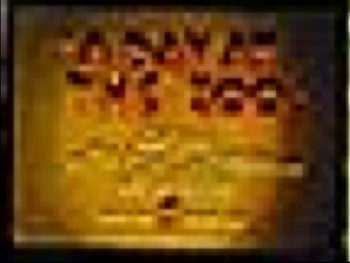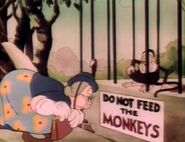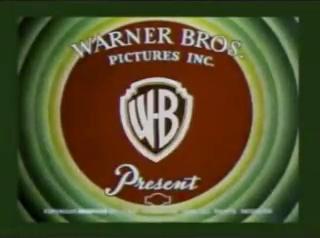A Day at the Zoo
Nội Dung Chính
A Day at the Zoo
← Previous
Next →
Gold Rush Daze
Porky’s Movie Mystery
Reissue
Original Title


Airdate:
11 March 1939
Blue Ribbon reissue:
8 November 1952
Series:
Merrie Melodies
MPAA Number:
Production Number:
5005
8747
1308 (reissue, not shown)
Starring:
Elmer Fudd
Crew
Voice Characterizations:
Mel Blanc
Danny Webb
Gil Warren
Director:
Fred Avery
Written By:
Melvin Millar
Producer:
Leon Schlesinger
Animated By:
Rollin Hamilton
(uncredited)Virgil Ross (uncredited)
Background Artist:
Art Loomer
Film Editor:
Treg Brown
Musician:
Carl W. Stalling
Video A
B
C
D
E
F
A Day at the Zoo is a 1939 Merrie Melodies short directed by Tex Avery.
Plot
A series of gags, usually based on outrageous stereotypes and plays on words, and topical references, is presented as a narrator (Gil Warren) describes a “tour” of the “Kalama Zoo” where the animals have nonsensical names, display anthropomorphic behavior, or illustrate punny gags.
- Some animals are in their “natural settings”: a wolf at someone’s door; “a pack of camels” smoking cigarettes (underscored by “The Campbells Are Coming”); a North American Greyhound (a moving Greyhound bus underscored by “California, Here I Come”); “two bucks and five scents” (two deer and five skunks); and “two friendly Elks” (conventioneers named “Bill” greeting each other).
- The monkey house includes monkeys tossing peanuts to zoo patrons; a baboon and a man who looks like the baboon, who end up trading places; and a Capuchin yelling at the top of its lungs, to a lady who tries to feed him some peanuts in defiance of the “Do Not Feed the Animals” sign: “Hey, sister, can’cha read?”
- A ground-hog [sic], along with its shadow in a separate cage, both pacing in sync.
- A skunk cage is a “scenter of interest” with the observers keeping a safe distance; the skunk is reading How to Win Friends and Influence People.
- A giraffe is being fed to the tune of the bugle “Mess Call”; the food chunks roll down its throat and into its stomach with the sound effects of junk crashing loudly.
- White rabbits are “multiplying” – operating adding machines.
- The bird house includes a “wise old owl”, who seems reluctant to accept the label; a parrot who talks like a street tough and wants a beer instead of a cracker; and an “Alcatraz jail-bird”, with a voice like Edward G. Robinson claims innocence, “I didn’t do it, I tell ya!” In the cage next door, the “stool pigeon”, in a somewhat effeminate voice, retorts, “Oh, he did so do it; I saw him with my very own eyes; so there!’
- A mother ostrich on her nest, clucking like a chicken, stumbles and breaks her large egg, which contains a dozen chicken eggs, and the narrator comments, “Well! A jackpot!”
- A newly arrived elephant is missing its proboscis, and after calling the express office on the phone, he says, “Ya know, those guys have had my twunk fow a week!”
- Some winged pink elephants are “left over from that last New Year’s Eve party!”
- A pair of panthers is pacing in their cage, saying, “bread and butter”, every time they pass a post.
- A retired lion tamer, J. Wellington Buttonhook, who used to put his head in a lion’s mouth as part of his act, puts down the paper he’s reading, revealing he’s headless.
- A Rocky Mountain wildcat is jumping around and acting crazy. The narrator asks, “What made you wild?”, and the cat responds, “They called my name out at Bank Night and I wasn’t there!” and resumes his crazy antics.
- A running gag features Elmer Fudd teasing a ferocious lion, with the narrator repeatedly warning him to stop. The first time, the narrator tells him, “Shame, shame. You’re a bad boy.” Elmer slinks away, involving Lou Costello’s catchphrase, “I’m a baaad boy!” (Starting from the second time) but keeps returning. Finally, the lion is alone, and the narrator comments that Elmer has learned his lesson. The lion slowly shakes his head, smiles, and opens his mouth. The eyes of Fudd appear from within the lion’s stomach, and Elmer Fudd’s voice echoes forth, “I’m a baaad boy!”
Caricatures
Availability
Censorship
- When this cartoon aired on Cartoon Network (as well as Boomerang and TNT), the brief shot of camels smoking cigarettes was cut.
Notes
- The final scene in this cartoon would be alluded to a decade later in “Hare Do” (1949), in which Elmer Fudd (who evolved from his first earliest derby hatted and squinty-eyed prototype) is swallowed up by a lion as part of the closing gag. Prototype-Elmer’s next cartoon, “Believe It or Else”, is a parody of Ripley’s Believe It or Not!
- This cartoon fell into the public domain in 1967 due to United Artists failing to renew the copyright on time.
- MeTV aired this short 7 May 2022 on Saturday Morning Cartoons, however, this airing appears unrestored.
Gallery





Smoking camels visual pun (scene edited on Cartoon Network, Boomerang, and TNT)






“HEY SISTER!!! CAN’T YA READ???”






Hello Bill! Hello Bill!

Original titles for “A Day at the Zoo” along with various other original titles












